From the very start, as a beginner in fishkeeping, I’ve always had my eyes wide open for new compelling swimming pet buddies.

I was trying to find the best and coolest possible fish combination to create a mesmerizing freshwater aquarium with happy inhabitants abundant in color and personality.
We can all agree that it is quite interesting to find out about the existence of exotic pretty fish with unique looks and inner worlds.
In this guide, I’ll help you uncover the colorful species that will suit your new aquarium best.
That being said, I’m positive that you’ll be able to discover almost all cool representatives of the prettiest and most brightly-colored freshwater fish that you can own at home.
Before we start, here’s how a beautiful Discus aquarium that’s dense on color and contrast looks like:
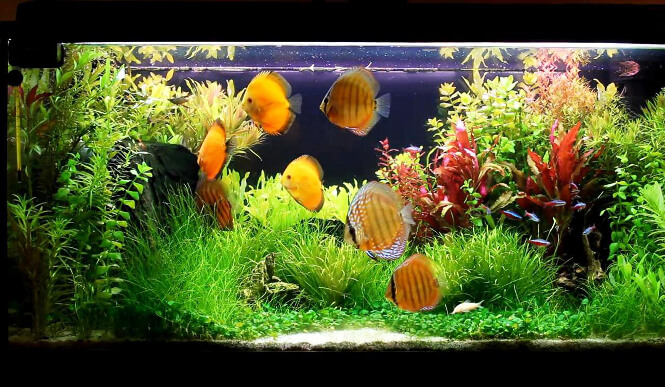
By IoanVladPappa
27 of the coolest freshwater aquarium fish
Most of these exceptionally colorful freshwater fish can contribute to an impressive display aquarium. Other species listed below stand out with their unique and exotic shapes and faces.
Here are the coolest freshwater fish that will make the prettiest aquarium:
1. Malawi Mbunas

By Brad
| Max. size: | 7 inches (18 cm) |
| Suggested tank size: | 30+ to 55+ gallons (depending on the max size of the specimen) |
| Water temperature: | 72.5 to 82.5°F (22.5 to 28°C) |
| Compatible with: | other Mbuna cichlids |
If you want to have a spectacularly colorful aquarium these freshwater fish are one of the top choices.
I have two hobby buddies that got into fishkeeping after me rambling about and showing them the pretty Malawi Mbunas.
Since these tropical fish are rock-dwelling cichlids, Mbunas’ tanks should be set with rocks, caves, and enough hiding places for everybody.
The grey background that this aquascape creates, makes the colors of this cichlid family stand out even more. That’s why the Mbuna aquarium is so enjoyable to observe.
Malawi Mbunas come in different shapes and sizes. They are part of the numerous types of cichlids coming from lakes in Africa.
Here are some examples of cool Mbuna species:
- Cynotilapia afra (can reach up to 4 inches)
- Gephyrochromis moori (4.5 – 5.5 inches)
- Labidochromis caeruleus (max size of 6 inches)
- Petrotilapia sp. Chitimba Bay (up to 7 inches)
The one seen on the photo is Labidochromis s. “hongi”.
It’s worth mentioning that some, like the Chitimba, have sexual dimorphism.
In their natural habitat male Mbunas compete for food and that’s why they tend to be aggressive and territorial toward one another.
To avoid that, especially in smaller tanks, you can play it safe and only get one male specimen with 3 females.
When deciding which fish species to incorporate in your tank, make sure that you don’t have two similar-looking species, as the Malawi Mbuna fish might confuse their partners.
This way you will avoid hybrids, which are not only less colorful but also tend to get more aggressive.
Suggested aquarium equipment for African Cichlids from the Malawi Mbuna family:
- For the lighting you can go with the NICREW ClassicLED light which is great for bringing out the color and beauty out of African Cichlids.
- I recommend a few options for filtration of a 55-gallon aquarium that’s decently stocked with Mbuna Cichlids. If you have a heavily stocked aquarium, use the Penn Plax Cascade 1500 canister filter which you can find at Chewy or on Amazon. If you’re looking for a budget-friendly alternative check this canister filter.
- As for maintaining tropical aquarium temperatures for your Mbuna cichlids, I recommend checking the 250-Watt version of EHEIM’s Jager heater. Find the Jager at Chewy by clicking here, or go over here to see it on Amazon.
2. American Flagfish – Jordanella floridae

by CheepShot
| Max. size: | 2.2 inches (5.5 cm) |
| Suggested tank size: | 10+ gallons |
| Water temperature: | 67 – 75°F (19.5 – 24°C) |
| Compatible with: | dwarf fish such as Guppies and Danios, Corydora catfish, pigmy suckermouths, groups of barbs or tetras |
The American Flagfish from the Jordanella genus is native to Florida.
This colorful Killifish immediately caught my eye when I first saw it in a small local fish store.
Not only is the American Flagfish pretty, but also it can take care of the accumulated algae in freshwater aquariums.
They usually grow up to around 2.2 inches, so you can go with a 10+ gallon tank.
The stronger coloration in males is the reason behind this species’ name.
Supposedly, the male Flagfish’s coloration is a resemblance to the American flag.
Females aren’t that saturated with different colors, but they also look attractive in their own way.
Remember that the colors, as with all fish, are ravishing only when you take proper care of your pet fish.
If you make sure that you’ve provided the proper water condition and if the Flagfish isn’t stressed out, it will show off the beauty it carries.
Bear in mind that the males may get a little territorial and aggressive.
To avoid that in small tanks you can go for 1 male and a few female American Flag fish.
In case you want more than 1 male, make sure that there is a larger group in the fish tank.
This way they will establish a pecking order, which establishes a leader and significantly reduces aggression.
The American Flagfish is curious by nature and therefore enjoys an abundance of hiding spaces.
They like it when their habitat contains some rocks, roots, and driftwood.
They also appreciate planted tanks, but make sure you don’t place soft-leaved aquatic plants, as the fish might eat the leaves.
Suggested aquarium equipment for an American Flagfish:
- I recommend keeping American Flagfish in a planted tank, so a good lighting option for one such 10-gallon aquarium would be the Finnex FugeRay Planted+ LED light.
- The American Flagfish are subtropical species and can be kept without a heater in warmer areas. However, if you live somewhere where it gets cold during fall and winter I can recommend the Cobalt Aquatics Neo-Therm aquarium heater. Its 75-Watt version is adjustable and small in size.
- To filter the water in a 10-gallon fish tank with American Flagfish you could use a simple a sponge filter.The needed Tetra air pump and Airline tubing can also be found on Amazon. For quick access, click here and here.
3. Rainbow Belly Pipefish – Microphis Deocata

By Roland13
| Max. size: | up to 5.9 inches or 15 cm, but in a home setting they usually grow to about 4.3 inches (11 cm) |
| Suggested tank size: | 10 gallons is the bare minimum but I would go with a 20-gallon long if possible |
| Water temperature: | between 64.4 and 77°F or 18 to 25°C |
| Compatible with: | for best results I would keep these fish with shrimp and snails only |
The Rainbow Belly Pipefish, a member of the Microphis genus, is a rare freshwater pipefish species that you may never get to see in real life.
I consider their rarity in the trade a good thing because these fish are extremely fragile.
Even if you had the chance, I’d recommend getting this pipefish only if you have considerable experience with keeping sensitive species.
The female Rainbow Belly Pipefish display exotic colors during their mating rituals.
The colorful ones are the females and the dull-colored ones are the males. With this species, the males carry the eggs.

By Roland13
Author’s note: Don’t expect the female Rainbow pipefish to show its stunning colors around the clock. Most of the time the females will look like a colorful version of the common pipesh. Here’s how a female looks normally:
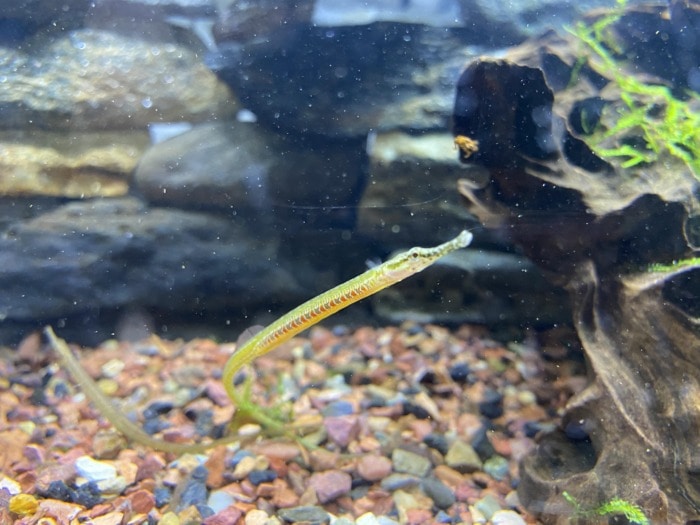
By harmchickenparm
Anyway, the Rainbow Belly Pipefish is pretty sensitive to water impurities and is also a micro-predator that does not accept live foods.
Its tank should be heavily planted and the water should be cool, with minimal movement.
This species tolerates higher temperatures but feels best at 68 to 70°F (20 to 21°C).
What I find to be most challenging about keeping Rainbow Belly Pipefish is feeding them.
They won’t touch commercial foods. This means that I would have to seed the aquarium with a live bug culture of some sort.
Some live prey that would sustain a Rainbow Belly Pipefish in your tank would be:
- Live daphnia;
- Freshwater copepods;
- Seed shrimp;
- Brine shrimp;
- The eggs of smaller freshwater shrimp.
If you decide to have your Rainbow Belly Pipefish in a shrimp tank, then the fish would “pluck” the eggs from underneath pregnant shrimp.
This should not be its only source of food in a tank, however.
Anyhow, keep these fish in a species-only tank, because they are very timid when feeding.
Almost any other fish will be able to outcompete the Rainbow Belly Pipefish during feeding time.
The equipment you’d need to look after Rainbow belly Pipefish:
- The Finnex Planted+ 24/7 CRV will help you grow some healthy plants in a long 20-gallon tank. This LED light will aid you in achieving a jungle-like tank, which is highly appreciated by the Rainbow Belly Pipefish.
- A sponge filter fits a Rainbow Belly Pipefish tank best. It does not create a lot of movement and it can gather microfauna for the pipefish to predate on.
- Though the Rainbow Pipefish doesn’t like too much heat it absolutely enjoys a stable water temperature. Make sure the heater you pick has a reliable thermostat that will activate it if temperatures start dropping too quickly.
4. Peacock Gudgeon – Tateurndina Ocellicauda
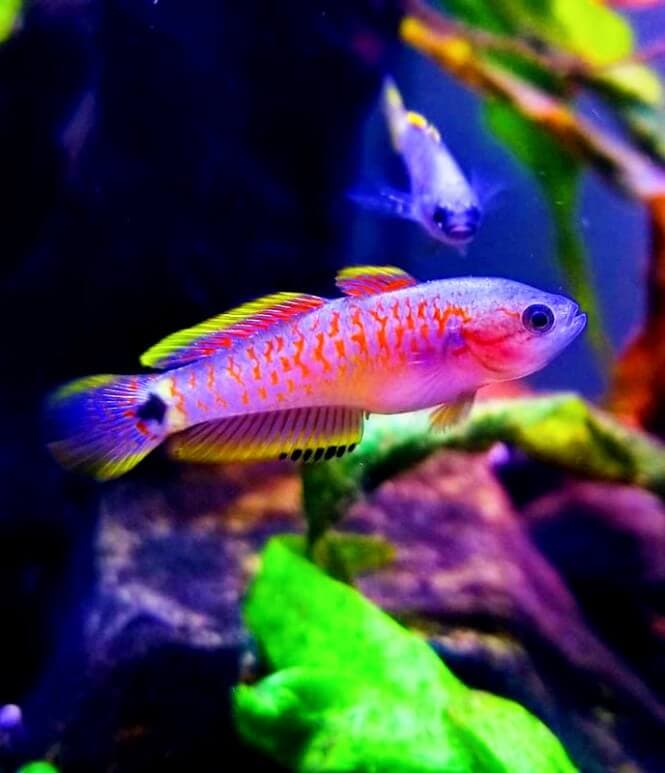
By wodesorel
| Max. size: | up to 2.5 inches and, rarely, 3 inches (or 6.3 cm on average) |
| Suggested tank size: | 15+ gallons for a one adult Peacock Gudgeon |
| Water temperature: | between 71 and 80.5°F (21.6 to 25.6°C) |
| Compatible with: | non-aggresive Gourami fish, Gertrudae rainbowfish, Panda cories (74 Fahrenheit is a suitable temperature in this case), Guppies and other fancy small fish, schooling Tetra fish, Rasbora fish |
The Peacock Gudgeon belongs to the Tateurndina genus, the species of which are spread in rivers and ponds in eastern Papua New Guinea.
The Peacock Gudgeon is one of those freshwater fish that have extremely vivid colors. In fact, if you visit that link you’ll find no less than 34 other fish that fall under that category.
Anyway, the best setup I can recommend for these guys is having 1 male and 2 to 3 female Peacock Gudgeons. If you want to keep them singly, they can be a good centerpiece species for a 20-gallon tank.
Another thing that you must take care of before getting these guys is having a nicely planted aquarium with plenty of hideouts.
The Peacock Gudgeon will likely not hide 100% of the time but they do need their personal space.
Nevertheless, they are social fish and enjoy the company of other Peacock Gudgeons.
This is more than welcome for anyone who wants to keep a group of exceptionally colorful freshwater fish in their planted aquarium.
An important thing to remember when keeping these beautiful fish is that they are strictly carnivorous and a diet of live, frozen live, or freeze-dried foods should be followed.
Suggested aquarium equipment for a Peacock Gudgeon:
- For a standard 20-gallon aquarium with a Peacock Gudgeon you’d likely need the Finnex Planted+ 24/7 LED lights. These lights will grow any aquarium plants, and help with your Peacock Gudgeon feeling at home at all times.
- You’ll need a canister filter for a decent filtration in a 20-gallon aquarium. Check out the Eheim 2215 canister filter which will ensure there’s enough water turnover. To find out more about this canister filter, click here.
- For heating the Peacock Gudgeon fish tank, check one of my favourite shatterproof heaters, The Cobalt Aquatics Neo-Therm.
5. Bristlenose Pleco – Ancistrus cirrhosus
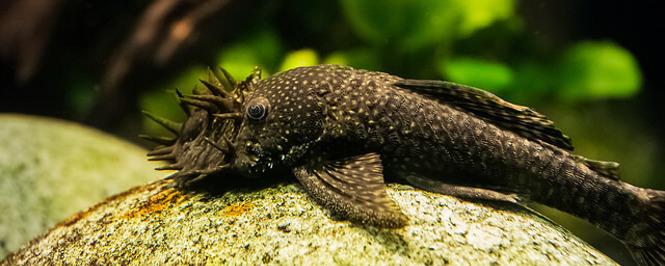
by Kurisu Mills
| Max. size: | 6 inches (15.2 cm) |
| Suggested tank size: | 30+ gallons |
| Water temperature: | 65 – 79°F (18 – 26°C) |
| Compatible with: | platy fish, groups of schooling fish such as tetras, barbs and danios, guppies, mollies, Goldfish, swordtails |
The Bristlenose Pleco comes from the Ancistrus genus of nocturnal freshwater fish. This unique bottom-dweller is popular among fishkeepers because of its uncommon look and the tendency to eat algae.
The Bristlenose pleco is a great beginner aquarium fish, as it’s hardy, not demanding, and small in size compared to other big plecos. It grows up to 5 or 6 inches maximum, which is a relatively small size for the pleco species.
This Birstlenose pleco’s exotic look and captivating behavior will have you smile every day.
What makes its appearance so interesting are the tentacles that sprout from its mouth with age.
You can see them better pronounced in male Bristlenose plecos.
Each Bristlenose Plecostomus has an individual personality that you’d love to get familiar with, over time.
There are different varieties like the Long Finned Bristlenose or the Albino Bristlenose.
They get annoyed with other bottom dwellers, so avoid housing them with such, especially if the species are similar-looking. It’s good to place a piece of wood as they not only love hanging out around that but it’s also thought the lignin in it is an essential part of their diet.
6. Bolivian Ram – Mikrogeophagus altispinosus
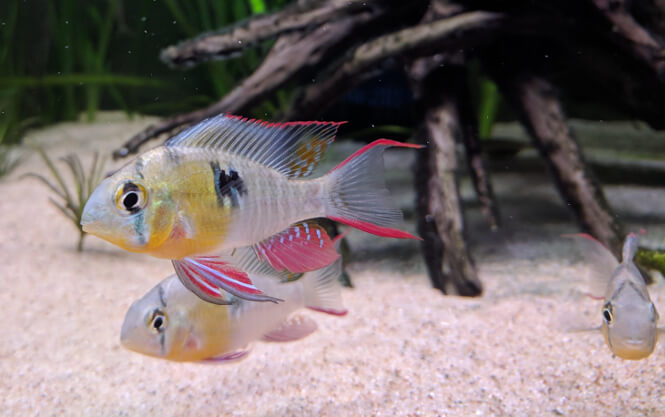
by Johnathanlegoeland
| Max. size: | 3 inches (7.6 cm) |
| Suggested tank size: | 20+ gallons |
| Water temperature: | 75 – 83°F (24 – 28°C) |
| Compatible with: | Tetras, Angelfish, less aggressive Gouramis (like Honey Gourami), Bristlenose plecos, in general – relatively peaceful community fish |
The Bolivian Ram is one of only two species in the Mikrogeophagus genus of small cichlids.
With its gentle appearance, pronounced coloration patterns and attractive fin design, the Bolivian Ram is generally believed to be the prettiest fish for a freshwater aquarium.
That being said, beauty also comes from within and these cichlids don’t make an exception with their good temper and peaceful souls.
It’s best to group them, as they feel much more comfortable when there are 6 to 8 of their own in a fish tank.
In case you want to own a group consider the bigger tank – 40 to 55 gallons.
However, it’s acceptable for the Bolivian Rams to be kept singly.
Mind that you should use soft sand for the bottom as a substrate for the aquarium.
The Bolivian Ram enjoys a well-planted aquarium with a few rocks, caves for hiding, and a driftwood piece.
This handsome fish can live well with other peaceful community fish too.
7. Powdered Blue Dwarf Gourami – Trichogaster lalius

by Hayrabet
| Max. size: | 3 – 3.5 inches (7.6 cm – 8.9 cm) |
| Suggested tank size: | 10+ gallons |
| Water temperature: | 73 – 81°F (22.7 – 27.2°C) |
| Compatible with: | Cory catfish, tetras, harlequin rasboras, zebra loach; |
Here is another example of a highlight fish for a relatively small tank.
Your eyes will be drawn to the attractively tinted Powdered Blue Dwarf Gourami, a member of the Trichogaster genus.
Breeders managed to develop the powdery blue color that we can enjoy. Bear in mind that males tend to get aggressive.
To avoid unwanted situations you can stick to a female powder blue gourami in there, especially in a smaller community tank.
Of course, males can also become part of your community tank. You should just make sure to avoid other surface-dwelling fish.
More than one male of this species isn’t recommended in less than 40 gallons of a heavily planted tank.
I’d suggest that you install a dark substrate to enhance the coloration of the gourami.
If you’re going to keep one of those tropical fish, bear in mind that they’ll need access to the water surface because they occasionally breathe atmospheric oxygen.
In that regard, never fill a closed-top gourami aquarium with water to the top.
Make sure to place the fish tank in a house room where there isn’t too much noise and constant traffic, as they will get stressed.
A benefit of keeping a Powdered Blue Dwarf Gourami is that it will occasionally hunt and eat freshwater snails. It’s a good dwarf fish for keeping aquatic snail infestations in small aquarium tanks under control.
8. Roseline Torpedo Shark – Sahyadria denisonii

By Anandarajkumar
| Max. size: | 5 to 6 inches (12.7 to 15.2 cm) |
| Suggested tank size: | 75+ gallons but go for a 125 gallon tank if you can |
| Water temperature: | 72 to 77°F (22.2 to 25°C) |
| Compatible with: | Tiger barbs (more than 6), Zebra danios (more than 7), Black skirt tetras (a school of at least 6), Siamese algae eaters, cichlids such as the Bolivian ram (fast-swimming); |
The also known as Red-line torpedo Barb, which belongs to the small Sahyadria genus, is another beguiling fish that I’ve mentioned before when listing freshwater shark look-alikes. Its looks and personality have me obligated to include it in this list as well.
The Roseline Torpedo comes from India and it’s an active schooling fish. As long as they form school, aggression will not be an issue.
You can place them in community tanks, but make sure you have at least 5 of them and so that they won’t bother others.
This way you will be able to acknowledge their friendliness and attractive behavior.
They like planted aquariums with gravel, rocks, and driftwood.
I’ve set a tank with a school of 8 Roseline sharks that peacefully shared it with angelfish.
However, I wouldn’t recommend this combination, as discus and angelfish are slow-swimmers and they can easily be stressed out by the red-lined barbs.
Mine just had chill personalities.
The Roseline Torpedo shark is an endangered species, so when purchasing, make sure the ones you get are actually fish tank raised, and not wild-caught.
9. Kuhli loaches – Pangio kuhlii
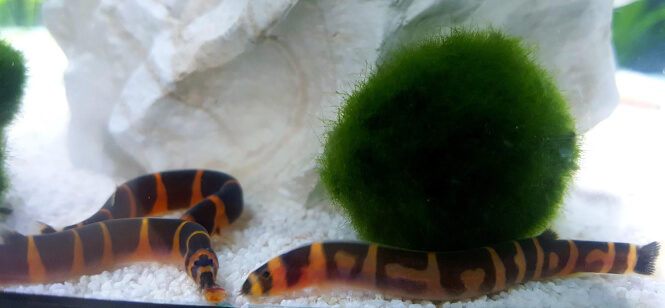
By aoi_kokoro
| Max. size: | 4 inches (10.1 cm) |
| Suggested tank size: | 20 gallons for juveniles and 125 gallons for adult specimens |
| Water temperature: | 76 to 86°F (24.5 to 30°C) |
| Compatible with: | peaceful, small enough not to be a thread species. Some cool ideas: Neon Tetra, Harlequin rasbora, honey gourami; |
The Kuhli loaches are part of the Pangio genus of over 30 species.
You can find Kuhli loaches and their eel-shaped bodies in different hues and with different color patterns.
Here in the photo, you can see a Pangio Kuhlii.
You can also find light orange to pink Kuhlis, some are patterned, others are brown-tinted or grey.
Depending on your color preference you can enrich your tank with these peaceful bottom-dwelling freshwater fish.
They are part of the eel-resembling fish that can be kept in freshwater aquariums. The resemblance is not only in the looks, however, as they “imitate” the behavior of true eels as well. You can see these scavengers during the day when feeding them.
For Kuhlis to be active in the daytime make sure they are in a group of at least 3, as they do not feel well when all by themselves.
Kuhli loaches enjoy planted aquariums abundant in hiding spaces.
It’d be great to place driftwood.
The substrate should be soft and in case you decide to place rocks make sure they are smooth river rocks.
You don’t want Kuhlis to harm their cool sensitive barbels!
I find it quite entertaining to observe them filtering the sand through their gills.
Kuhli Loaches can share a tank with almost all likewise peaceful species that need similar water conditions.
And of course, make sure tank mates are small enough not to eat the, may I say, Coolies.
10. Multicolored Crowntail Betta – Siamese fighting fish
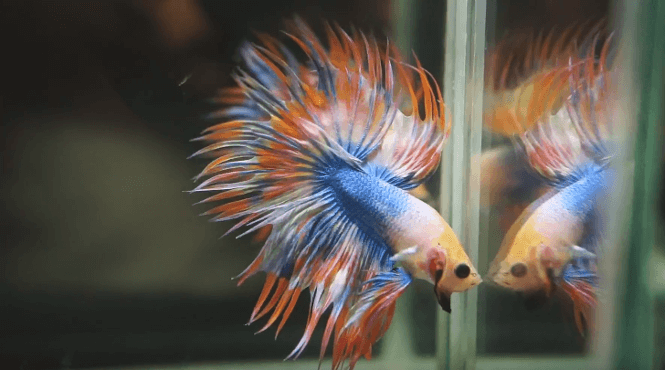
by MoMo Bettas USA
| Max. size: | generally up to 3 inches long (7.6 cm) but will usually remain at 2.7 inches (6.85 cm) |
| Suggested tank size: | 5+ gallons for a solo specimen |
| Water temperature: | 75 to 82°F (24 to 28° in Celcius) |
| Compatible with: | Dwarf fish such as danios or rasboras, dwarf corydoras,a single pleco from the small ones, Short-fin tetras, Small and active shrimps, dwarf Loaches, most snails, dwarf livebearer fish, Bristlenose catfish. Click here to see more options for tank mates. |
The Siamese fighting fish is the best-known member within the species of the Betta genus.
Because of their attractive appearance and the somewhat misleading “no care needed” information roaming around pet stores and the internet, the Betta is one of the most widely spread fish among households.
Depending on the breed, the multicolored Crowntail Betta can be generally considered as the most brightly-colored freshwater fish. Some more expensive breeds such as the Marble Betta include more than 5 different warm colors.
Moreover, Marble Betta fish will occasionally change their colors due to their genetics. Anyway, your eyes will be drawn to the Siamese fighting fish, be it Half-moon, Superdelta, Overhalfmoon, Rosetail, etc.
Crowntails though, I find quite outstanding with their particular fins, especially when bathed in multiple colors.
Some people say those fins contribute to a not-quite-appealing insect look, but I strongly disagree with that statement.
I would say this type of Betta is a bit harder to keep because of the fragile crownlike fin texture.
The spikes catch on things easier as well, but proper tank maintenance and making sure there aren’t sharp-edged decorations will help Crowntails thrive.
Remember, if you decide on a Betta, don’t keep it in one of those small bowls – it is an active fish that needs enough space to swim around. If you’re just starting out in the hobby and want to try this fish out, then you should probably read this guide on fish tanks that would best suit a Betta.
It’s also really important not to overfeed your new pet Betta. Overfeeding may sometimes lead to Bloat in Betta fish. You should remove any food leftovers 5 minutes after feeding your betta.
Do proper research on how to take care of your pretty Siamese fighting fish and you will be able to enjoy its company for more than 4 years.
I recommend you check: 9 Extremely Rare Betta Fish
11. Angelfish – Pterophyllum
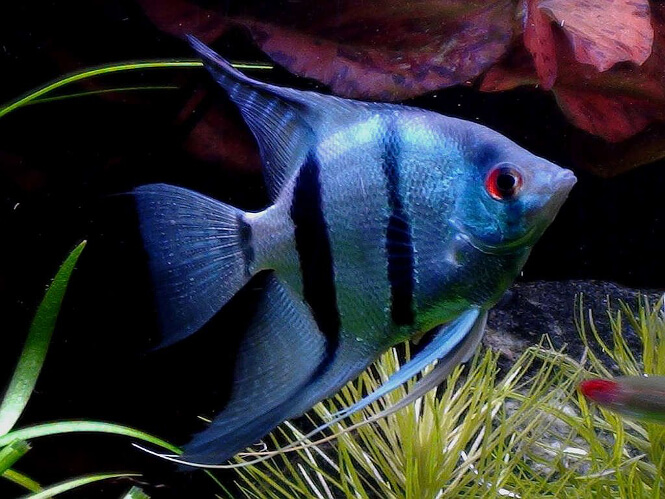
By CichlidsAndPlants
| Max. size: | 6.2 inches long, 8.2 inches tall (15.7 cm long and 20.8 cm tall) |
| Suggested tank size: | 29+ gallons |
| Water temperature: | 74 – 83°F (23.3 – 28.3°C) |
| Compatible with: | Elephant nose and the snake loaches, Kuhli loach, big enough tetras as Red Eye Tetra, Catfish like the Bristlenose pleco, Dwarf Gourami, Bolivian ram, Mollies (some Mollies are fin nippers, so make sure yours aren’t by observing their behaviour); |
With its uncommon body shape and cool color varieties, Angelfish from the Pterophyllum genus often play the “highlight of a freshwater tank” role.
If you want to add a spectacular fish to your 29+ gallon community tank, you can go for one of those beauties.
Angelfish as most cichlids, especially when reaching adulthood, get territorial and aggressive.
In a 29 gallon tank, you shouldn’t add more than one.
In a bigger tank, you can have a pair, but these make monogamous mated pairs tend to get even more defensive.
They feel best in planted tanks with hiding places.
Their compatibility with other fish varies.
Generally, you can avoid fish small enough to fit in their mouth and fin nippers.
12. Royal Whiptail Catfish – Sturisoma panamense

By caswal
| Max. size: | 8 inches (20.3 centimeters) |
| Suggested tank size: | 30+ gallons |
| Water temperature: | 73 – 79°F (22.7 – 26°C) |
| Compatible with: | Gouramis, dwarf community fish, Corydoras, a group of Kuhli loaches; |
Also known as ‘twig catfish’ this bizarre-looking freshwater fish comes from the Sturisoma genus and became popular for its ability to graze on algae.
It’s a peaceful fish that needs hiding spaces in the tank to handle stress.
It’s a bit shy, especially during the day, but when it decides to reveal itself in the tank for a bit longer I love to stare at this exotic whip-tailed buddy as long as it lets me.
Despite its uncommon and exotic look the royal whiptail is a community fish and gets along with others fine.
Still, you should avoid any semi-aggressive or aggressive tank mates.
Even though it is an algae eater the twig catfish needs diet diversity, which you can provide by feeding it with sinking pellets and bloodworms.
13. Agassiz’s dwarf cichlid – Apistogramma Agassizii

By dbcyeo
| Max. size: | 3.6 inches (9 cm) |
| Suggested tank size: | 20+ gallons |
| Water temperature: | 77 – 84°F (25 – 29°C) |
| Compatible with: | Cardinal Tetra, Kuhli Loach, Julii Cory, Dwarf rainbowfish, Barred Espei Pencilfish, Dwarf Gourami; |
The vibrant colors of the Apistos attract the attention of a lot of fellow hobbyists. They are a dwarf cichlid species and are often called Apistogramma, same as the name of their genus – Apistogramma.
You can choose between gold, blue, and red Apistogrammas when deciding what would be the preferred hue of the fish that you will incorporate in your tank.
These dwarf cichlids are small – they can reach up to 3,6 inches.
They are classified as community fish.
The best tank mates for Apistogramma would be some peaceful and small species of fish. For example, cardinal tetras are a good idea.
They enjoy planted tanks with river rocks.
When deciding how many of these cuties to adopt, be aware that a good rule of thumb is to only have one Apisto, especially in a smaller tank.
You can get away with having two Apistos in a 29gallon community tank if they are a mated couple, but never 2 males.
Here on the pic, you can see a double red Apistogramma agassizii.
The coolness is obvious, so to your gratitude that I pointed this fish out I can gladly say – YOU ARE VERY WELCOME!
14. Boeseman’s rainbowfish – Melanotaenia boesemani

| Max. size: | 4.5 inches (11.4 cm) |
| Suggested tank size: | 55+ gallons |
| Water temperature: | 77 – 83°F (25 – 28°C) |
| Compatible with: | Tiger barbs, other similar by size Rainbowfish, Danios, Bristlenose pleco, Cory catfish, Swordtail fish; |
The Boeseman’s rainbowfish is a species within the large Melanotaenia genus.
You’ll immediately fall in love with the Boeseman’s Rainbowfish and its vibrant appearance.
Not only are their merging saturated colors exceptional, but these beautiful rainbowfish are peaceful and compelling by character.
They are schooling species, so make sure you have at least 6 in a tank.
They love the well-planted environment, but still – give them enough space to swim, as they will appreciate it. This way you will be able to enjoy their vivid nature roaming around actively.
A long 55+ gallon fish tank would be perfect for housing the Boeseman’s rainbowfish. It is worth noting that taking good care of these marvelous creatures, can result in 10 or more years of lifespan, all while beautifying your aquarium.
And I can ensure you that there is no better feeling than having fish that recognize and interact with you because of the long friendship you’ve established.
15. Chili Rasbora – Boraras brigittae
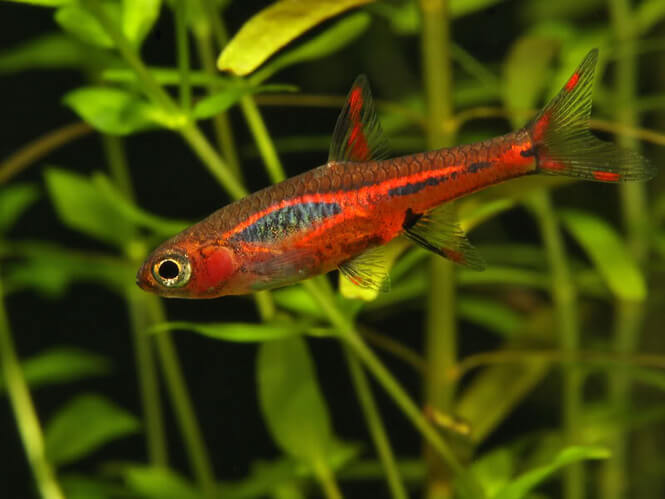
By Peter Macguire
| Max. size: | 0.78 inches (2 cm) |
| Suggested tank size: | minimum of 5 gallons but 10 gallons would be better |
| Water temperature: | 75 – 82.4°F (23.9 – 28°C) |
| Compatible with: | other rasboras (Neon blue rasbora – also nice color) Julii Cory, Panda Cory, freshwater shrimp as Cherry shrimp, Neon tetras |
The Chili Rasbora, assigned to the small genus known as Boraras, is a great schooling fish that loves a planted aquarium with some driftwood in it. These fish are tiny and will reach a maximum of one inch, but they have the confidence of a 4+ inch fish.
Chili rasboras love swimming around and have strong red coloration which stands out beautifully on the green background of a well-planted fish tank.
If you want a multicolored tank with cool, yet small fish in it you can consider a school of Mosquito Chili Rasboras.
They look great in smaller nano community aquariums, but 100 or more Chili Rasboras could contribute to a pretty exotic view in a larger 55+ gallons as the school creates a mesmerizing red veil flattering the overall sight.
You may keep between 10 and 12 Chili Rasbora fish in a 5-gallon aquarium with live plants.
Visit the link to discover more nano fish options for small tanks.
16. Golden Honey Gourami – Trichogaster chuna
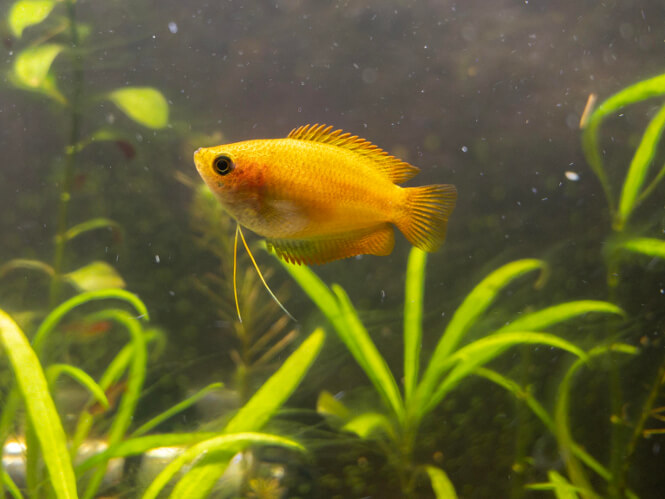
By Eternalcheddar
| Max. size: | 2.5-3 inches (6.3 cm – 7.6 cm) |
| Suggested tank size: | 20+ gallons |
| Water temperature: | 72 – 82°F (22.2 – 27.7°C) |
| Compatible with: | small tetras and corydoras, Platy fish, guppies, freshwater shrimp; |
The Golden Honey Gourami, same as the Powdered Blue Dwarf Gourami, belongs to the Trichogaster genus of gouramis.
The sweetness in this Gourami doesn’t only show through the colors, but also through their personality.
Males have this strong yellow honey-ish vibe going on, while female’s coloration is a bit duller.
When feeling emotionally and physically well, like any other fish, their color will get more and more saturated.
Make sure your gourami tank has enough vegetation and hiding spots, where it can find its peace.
The Honey Gourami fish is hardy and a great choice for beginners, especially if you’re looking for a bit bigger centerpiece specimen in a relatively small aquarium with tiny schooling species.
They enjoy having friends from their own kind, so if there is enough room – a group of 4 to 6 gouramis will provide an interesting environment to observe social behavior.
17. Blue Dolphin Cichlid – Cyrtocara moorii

By ISOF
| Max. size: | 10 inches (25.4 cm) |
| Suggested tank size: | 125+ gallons |
| Water temperature: | 73 to 80°F (22.8 to 26.7°C) |
| Compatible with: | Frontosa Cichlid, Deepwater Hap, Taiwan reef cichlid, One and a half stripe hap, White Tail Acei, Sunshine Peacock Cichlid; |
The Blue Dolphin Cichlid, or moorii as it’s popular in the hobby, is the only known member of its Cyrtocara genus.
This curious-looking Blue Dolphin cichlid is a great well-tempered big guy that grows up to around 9 inches.
As you can see on the pic when fully grown it develops this large bump on its head that along with the vibrant blue color, makes it so compelling.
Avoid having 2 males in the same tank as they tend to get aggressive towards one another.
They are polygamous so 1 male with at least 3 females will be the best combination.
Contrary to other cichlids I’ve mentioned these are more peaceful and you can easily keep them with other non-violent cichlids.
They will appreciate a large open area to move around, so the bigger the fish tank – the better. They like fine aquarium substrates (either gravel or sand) and would burrow down into it.
Avoid rocks all around the tank, as it might hurt them. You don’t want this long face to get any longer.
18. Red Wagtail Platy – Xiphophorus Maculatus

By Marrabbio2
| Max. size: | 2 inches (5 cm) |
| Suggested tank size: | 10+ gallons |
| Water temperature: | 73 – 77°F (22.7 – 25°C) |
| Compatible with: | Corys, Tetras, Guppies, Harlequin rasboras, Pearl gourami, Honey Gourami; |
The Red Wagtail Platies are among the various species that belong to the Xiphophorus genus.
What makes the Red Wagtail Platy and Platies in general so special is not only their vibrant coloration but also the fact that they are easy to take care of. If you’re looking for hardy fish that do not require much maintenance and are beginner-friendly then you can check the link above.
I made sure to list species that are resilient but also attractive.
Anyway, wagtail platies are also tiny and barely reach 2 inches, which makes them great for smaller freshwater aquariums.
They are not schooling fish, but they feel better when in groups.
Always place a tank cover on top of the aquarium as they tend to jump.
A friend of mine named his platy Kamikaze, as he had to pick him up several times from the ground outside the tank. He then noticed a really small gap that Kamikaze was using to fly away.
Seal all possible getaways if you decide on the Red Wagtail.
19. Glass Catfish – Kryptopterus vitreolus
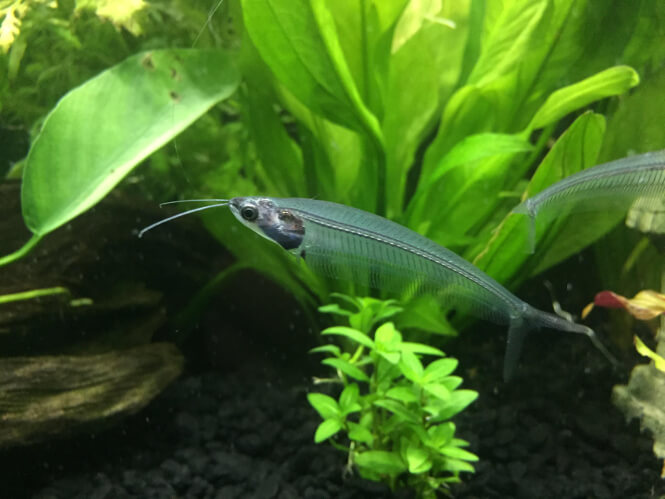
By VodooRanger
| Max. size: | 3.1 inches (7.8 cm) |
| Suggested tank size: | 30+ gallons |
| Water temperature: | 74 – 79°F (23.3 – 26.1°C) |
| Compatible with: | Small Tetras (neon, Pristella Tetra) and Rasboras, Bristlenose plecos, Platties, Dwarf Gouramis; |
The Glass Catfish is a species within the Kryptopterus genus, which populates freshwater throughout Southeast Asia.
The glass catfish is one of the most unique-looking freshwater fish available in the aquarium trade.
The transparency of their bodies contributes to an exotic look that is rarely found in other fish suited for home aquaria.
I love these glass-like fish as they are not only mesmerizing but also possess a great personality.
They are schooling fish, so make sure that you’re housing at least six of them in the aquarium to keep them happy.
Glass Catfish are pretty sensitive when it comes to water parameters and frequent fluctuations in water parameters will be harmful to them.
You should put them in an already settled tank that should be often checked and maintained.
Glass Catfish enjoy a well-planted tank with places to hide and enough swimming space.
They might appear with different tints depending on the light.
20. Full-Platinum Albino Guppy – Poecilia reticulata

By heydre1
| Max. size: | 2 inches (5 cm) |
| Suggested tank size: | 5 or more gallons |
| Water temperature: | 76 – 80°F (24.4 – 26.6°C) |
| Compatible with: | corydoras, shrimps, Bristlenose plecos (bottom dwellers); |
The Full-Platinum Albino Guppy comes from the well-known Poecilia genus.
Platinum Albino guppies have this soft and gentle look and feel to them.
They contribute to a truly gorgeous fish tank while providing a sense of calm.
Guppies, in general, can be found in many pretty bright colors, with different fin types making them real eye candy.
If you are a beginner in the hobby, guppies are a very good option for your first fish tank.
They feel best in groups of 6 and more.
This is excellent for you as you’ll be able to keep differently colored guppies in the same tank together.
They will complement each other look-wise and will also be happy.
Females should always outnumber males.
As platies, guppies are livebearers, so expect them to be raising in number over time.
Even if you have a 10-gallon tank you can keep 5-6 beautiful guppy fish in it.
21. Black Molly – Poecilia sphenops

By Marrabbio
| Max. size: | 5 inches (12.7 cm) |
| Suggested tank size: | 20-gallon tank or larger |
| Water temperature: | 75 – 81°F (23.8 – 27.2°C) |
| Compatible with: | schooling Danios, a female Betta, Platy fish, a group of tetras, Guppies, Swordtails, Gouramis, Angels, Endler’s livebearers; |
Same as the Full-Platinum Albino Guppy, the Black Molly belongs to the Poecilia genus.
Black mollies appreciate the planted aquarium and look incredibly sharp when putting in one.
They stand out really nicely on the lush green background.
Apart from their looks, Black Mollies have unproblematic behavior and are rather hardy, which makes them a fitting choice for beginners.
Bear in mind that in case you keep 2 or more males in the tank, females should outnumber them at least twice.
Another great quality of the black Molly is that it eats algae.
So it can actually do maintenance in your tank.
Here’s a friendly tip – the contrast created by black mollies in a tank with some brightly colored tank mates is truly eye-pleasing.
22. Flowerhorn cichlid – hybrid species

By Buildingnumberseven
| Max. size: | up to 16 inches (40 cm) but usually around 12 inches (30 cm) |
| Suggested tank size: | 70+ gallons |
| Water temperature: | 82 – 86°F (27.7 – 30°C) |
| Compatible with: | Jack Dempsey cichlid, Texas cichlid, Blood parrot cichlid, Leopard pleco; |
The Flowerhorn cichlid is a unique cichlid hybrid that immediately draws attention with its bright colors.
When it matures it grows this spectacular nuchal Kok (the exotic-looking bump on their head).
The Flowerhorn Cichlid is considered the most colorful cichlid fish species.
Thanks to their selective breeding these cichlids have a heavily diversified coloration all across their bodies.
Fun fact: There is a belief that if you keep a Flowerhorn Cichlid in your home you can change your luck and bring yourself prosperity and peace.
Most Flowerhorn Cichlids grow up to 12 inches, but some of them can reach up to 16 inches depending on the hybrid species. Because of their size, they require large tanks.
Related: Top Cichlid Foods to Improve Growth
Those fish are aggressive and it is best for them to be kept alone.
If you still want to try a few tank mates with Flowerhorn Cichlids – you can.
But bear in mind that the tank should be at least 175 gallons.
There should be enough space and hiding spots because most acceptable tank mates are also territorial.
A Flowerhorn Cichlid fish can develop a strong relationship with its owner.
If you take proper care of this outstanding buddy, it will interact with you, show excitement when seeing you and even let you pet it. Here’s someone on YouTube.com petting his.
So just make sure it’s doing well and is not stressed and it will show off its beautiful colors and personality.
23. Celestial Pearl Danio – Danio margaritatus

By amanofscience
| Max. size: | 1 inch (2.5 cm) |
| Suggested tank size: | 10 gallons |
| Water temperature: | 71 – 78°F (21.6 – 25.5°C) |
| Compatible with: | freshwater snails, adult shrimp (will eat juvenile), Guppies such as Endler guppie, Bristlenose pleco, Tetras (like Cardinal or Ruby tetras), Corydoras (like Pigmy cories), Harlequin rasboras, Chili Rasboras, Cherry Barbs; |
This small freshwater fish is a member of the Danio genus.
Anyway, some say “size doesn’t matter” and this fish screams it with its whole being.
The Celestial Danio can barely reach 1 inch but has exceptionally cool looks and a fun personality.
Therefore this species of fish can be considered one of the smallest freshwater aquarium fish that are also exceptionally colorful.
That being said, if you’re interested in freshwater nano fish in general, I can recommend checking out this comprehensive list. Click the link to have a look at some super tiny micro fish that will do well in smaller fish tanks.
Males are more brightly colored than females, but the latter is needed to ensure peace and balance in your group of danios.
Celestial Danios are active fish, well-kept in nano community tanks. You can set up a lovely aquarium with some easy plants like the easy-to-care-for Microsorum Pteropus and rocks and they will swim around the aquascape showing off their nice shades, spots, and stripes.
24. Checkerboard Discus
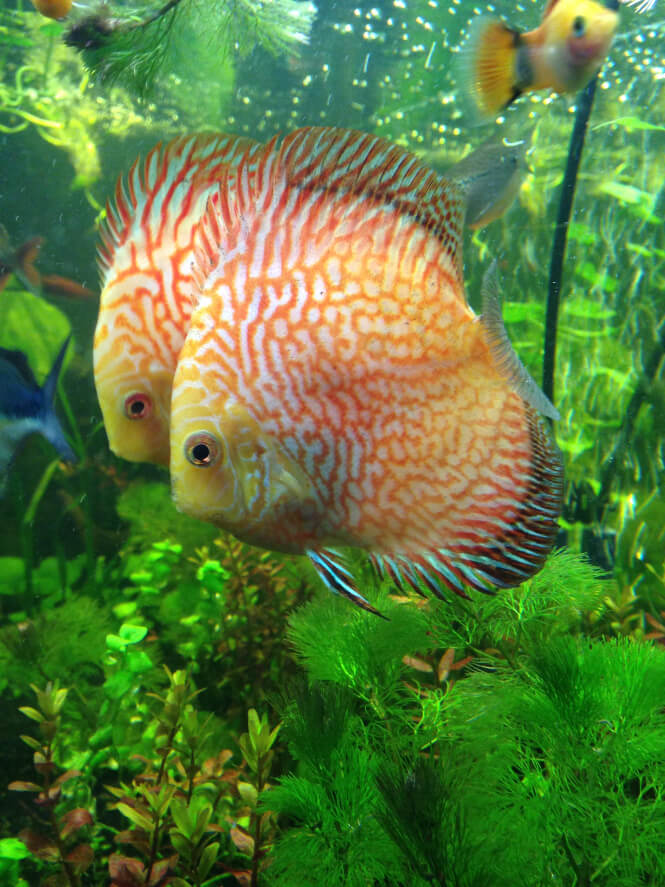
By sedialpha5
| Max. size: | Generally 6 inches (15 cm), but can grow larger than 9 (22.8 cm) when being overfed with high-quality food and housed in a large tank with proper water conditions |
| Suggested tank size: | 75+ gallons |
| Water temperature: | 84 – 87°F (28.8 – 30.5°C) |
| Compatible with: | Cardinal Tetras, Sterbai Corydora, Bristlenose pleco, clown loach, Kuhli loach, Harlequin rasbora, Cory catfish, Moonlight gourami; |
The Checkerboard Discus belongs to the Symphysodon genus of cichlids which inhabit the Amazon river basin.
The Checkerboard Discus is a cool-looking freshwater aquarium fish that will excite your visual senses with its bright color.
Not only its exotic coloration but also the shape of the discus fish’s body is quite the sight.
You can find it in a huge palette of different hues and create an outstanding single specimen tank.
They love being in groups of at least 6 and females should always outnumber males.
Discus fish are to be kept in high temperatures and need frequent water changes.
If you are a novice in the hobby and you think that Discus will be your first fish ever – think twice.
You should do proper research and be prepared to put in the effort in raising these beauties.
This applies to a degree to every fish, but still…
Discus like planted aquariums.
The live plants should be tolerant of the high temperature as Discus are tropical freshwater fish.
The Anubias plant is an often recommended choice.
A discus-based aquarium can be one of the most attractive setups in the freshwater fishkeeping hobby.
25. Panda Cory – Corydoras Panda

by HolyCarp
| Max. size: | 2.5 inches (6.4 cm) |
| Suggested tank size: | 20 gallons |
| Water temperature: | 72 to 79°F (22 to 26°C) |
| Compatible with: | Small sized danios, tetras, rasboras and other peaceful dither fish. |
Panda Corys (Corydoras Panda) are small bottom dwelling fish that are a great choice for Asian biotope tanks.
Their name is derived by the two black markings that give them a panda-like appearance.
Their signature look is further complemented by a pinkish body that’s covered in a hard exoskeleton.
The character of panda corys is equally charming as their beauty.
They are well-mannered and can get along with most equally sized, peaceful species.
And even though they can be kept with other bottom dwellers, it’s best to house them with dither fish that won’t compete with them for food.
Additionally, you’ll want to get at least six of them since they’re schooling fish that will suffer poor health if their numbers are low.
Since they have delicate whiskers, panda corys can easily get hurt on sharp decor or gravel.
So to keep their whiskers intact, you will need to line the aquarium with smooth substrate and be mindful about the decor.
26. African Butterfly Fish – Pantodon buchholzi

by CheepShot
| Max. size: | 6 inches (15 cm) |
| Suggested tank size: | 40 gallons |
| Water temperature: | 73 to 86°F (23 to 30°C) |
| Compatible with: | Small bottom-dwelling cichlids, catfish, large barbs and tetras. |
The African Butterfly Fish is somewhat of a living relic as it’s the only surviving member of the Pantodontidae family of ray-finned fish.
And it doesn’t take you more than a single glance to realize this species belongs to a different era.
With their thread-like ventral fins and upturned mouth, African butterfly fish seem like miniature dinosaurs.
And these aren’t for show either.
The ventral fins help butterfly fish stay afloat, while their upturned jaw lets them easily capture small insects floating on the water surface.
But the most interesting thing about these fish is their ability to glide over the water surface. They achieve this by propelling themselves with their broad caudal fin and using their wing-shaped pectoral fins to glide in the air. Which is quite handy when you’re trying to evade predators.
Amazing, right?
Well, even though owning a flying fish might seem cool on paper, it does come with its caveats.
First of all, you’ll need to keep African Butterfly fish under a tight lid, so you’ll never see their purported flying skills in action.
Secondly, African Butterfly fish are finicky eaters that need to be fed with live foods.
I’ve read reports about aquarists who’ve managed to keep their butterfly fish on a diet of flakes and pellets.
Such cases, however, are few and far between. In reality, you’ll need to feed these fish with live crickets primarily.
And lastly, butterfly fish aren’t the most interesting species behavior wise.
Since they’re an ambush predator, they’ll spend their entire time just beneath the water surface, awaiting prey.
If all of this hasn’t deterred you, then you should keep a few other things in mind before you get a butterfly fish.
African Butterfly fish require an aquarium with a long footprint, so they can freely move around. The minimum tank size for a single specimen is 40 gallons. In terms of tank mates, you can keep them with bottom dwelling species such as plecos, as well as large and peaceful fish like tetras.
Smaller species can also work as tank mates, as long as they stay away from the top of the aquarium.
27. Samurai Gourami – Sphaerichthys vaillanti

by BallerBettas
| Max. size: | 1.8 to 2.2 inches (4.5 to 5.5 cm) |
| Suggested tank size: | 30 gallons |
| Water temperature: | 75 to 80°F (23.8 to 26.6°С) |
| Compatible with: | Small rasboras, loaches, and barbs. |
The Samurai Gourami from the Sphaerichthys genus is one of those fish that rarely pop-up at conventions or online retailers.
Getting your hands on one in any other case can be downright impossible.
And even if you do manage to do it, you’ll need to provide the Samurai Gourami with special care.
Therefore, you should stray away from this species unless you have some experience under your belt.
Anyways, samurai gouramis typically inhabit peat swamps and black water streams that are rich in decaying plant matter.
Having a leaf-shaped body, they easily blend with their environment and avoid predators.
As a result of their habitat, samurai gouramis need soft, acidic water with a pH of 3.5 to 6.5.
A great way to keep the pH low is by adding plant litter, peat moss or driftwood.
This will not only keep the acidity in check, but also make your samurai gouramis feel right at home.
Since samurai gouramis are extremely timid, you’ll need to keep them with peaceful and slow moving species that won’t scare them off.
Small rasboras, corydoras and barbs are just a few of the species that come to mind.
What is the best combo for a colorful freshwater fish tank?
If you want to know how to create an exceptional eye-pleasing fish tank, you should take into consideration the compatibility of the fish and of course – their colors.
When it comes to hues, here you can find a great, simplified article covering the color theory, that will help you scientifically become aware of long-proven combinations that make each shade and tone stand out.
Here’s a picture of the color wheel for your reference:

By Presentitude.com
That being said, tested examples of the best freshwater aquarium fish combinations for color are:
If you have a planted aquarium then you should go for brightly colored fish that are on the opposite of green in a color wheel.
This would mean introducing orange, red, or purple fish to the fish tank.
Red plants will contrast better with light-blue or yellow fish.
A fish-only setup would benefit from multi-color community species such as African Cichlids or Discus and schooling fish, such as guppies and danios.
The best combinations for a colorful fish tank with live plants include:
- Swordtails coupled with Guppies or Mollies
- Platies and Harlequin rasboras or Neon tetras
- many varieties of Discus with a school of Kuhli loaches
- Different varieties of Killifish
- Pink Chili Rasboras and Neon blue rasboras
- Cherry Barbs combined with Celestial danios or Chili rasboras
- Red honey gouramis in the company of neon tetras
- Red or Pink betta with an Albino cory.
It would, of course, be beneficial if the fish in these combinations are proven to fit each other in terms of temperament.
Visit my article on the best and most peaceful community fish for more ideas.
Anyway, here’s a picture of a pretty planted tank with contrasting freshwater fish:

By Havage
Red plants in an aquarium will contrast more with yellow or blue fish such as the Powder blue Gourami, a turquoise, or lemon-yellow Discus.
Mind that both red freshwater plants and gouramis are advanced-level care. The red aquatic plants would need dedicated LED aquarium lighting.
Anyway, for a fish-only setup, you’d want to combine fish that have either contrasting or analogous colors.
Some vibrantly colored species combinations for a fish-only aquarium are:
- Different varieties of cichlids
- Differently-colored discus fish
- Small and fast, brightly-colored schooling fish such as neon Tetras, Guppies, Swordtails
- An angelfish-only fish tank.
A photo of a fish-only aquarium housing some very brightly-colored cichlids:

By Alexdare7
If you prefer to install a background on your FO (fish-only) aquarium, it is generally better to go for dark blue or a black one.
Fill the tank with brightly-colored fish for a maximum visual impact and contrast.
See the contrast between a dark aquarium background and fish with warm colors here:
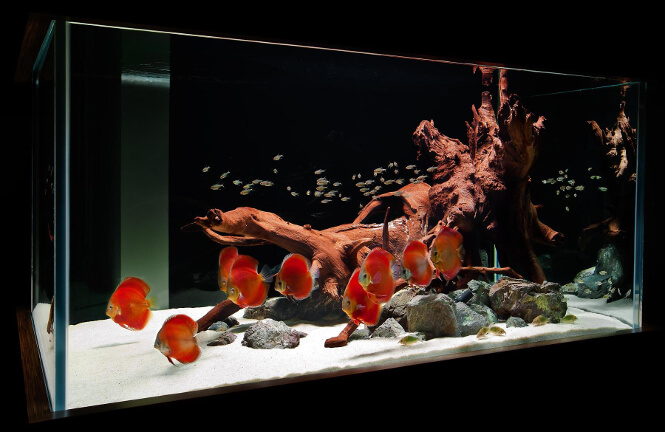
Which is the best one if you are a beginner?
After all, if you are a beginner in the hobby and you want fun and colorful fish, the best option for you has already emerged among these freshwater buddies.
The best freshwater fish for beginners are the Platies.
They are not demanding when it comes to feeding and water parameters.
They reach up to 2 inches. You can keep 5 of them in a 10-gallon tank as a starter in the hobby.
Platies will also be more than satisfied with just the basic equipment a fish tank needs. You can find different types of platies in a variety of colors.
They are also peaceful and tank mates would be easy to find.
As a novice in the hobby, you would be able to create a cool fish tank with happy and active platies.
A photo of a platy-based aquarium that’s pretty cool and looks exotic:

By QuantiTect
My Conclusion
You could own a lot of unique fish that can help you create a gorgeous tank.
If you put in the effort to set up a nice aquascape and ensure a healthy environment for your pet fish, it will pay off.
Happy fish show their pretty colors more and also develop fun personalities.
You can only have one centerpiece species in your freshwater aquarium and still achieve fascinating results and the coolest fish tank.
Sometimes, especially when it comes to some of the more aggressive vibrant species that I’ve mentioned above – quality overshadows quantity.

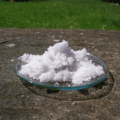



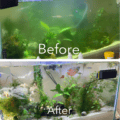

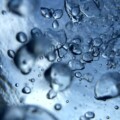

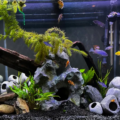

11 thoughts on “The Coolest & Most Exotic Freshwater Aquarium Fish”